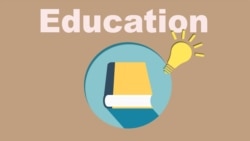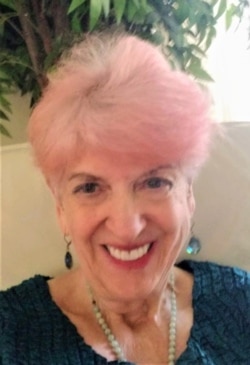Peace Education is a growing area of research at some colleges and universities. Peace education programs often explore subjects covered in the news, such as violence in schools and mental health issues during a quarantine.
In Japan this week, Rebecca Oxford was to speak at a meeting of JALT, the Japan Association for Language Teaching. Her subject: “The Language of Peace.”
Oxford is Professor Emeritus at the University of Maryland in the United States. She says that foreign and second language teacher-educators and their students have an important duty to play in fostering peace. She adds peace is created through communication, and that communication is the main goal of language teacher-educators and teachers.
Six parts to peace
Oxford says there are six parts to peace. They are inner peace; interpersonal peace; inter-group peace; intercultural peace; international peace; and ecological peace or care for the environment. She believes these six terms give teachers a common basis on which to talk about conflict and work for peace.
Part of Oxford’s approach to the language of peace is to change signs of conflict into respect for the values and hopes of the people involved. She says peace builders should look for the causes of conflict and use this information to reduce violence between people, groups and cultures.
Criticism of peace education
Not everyone agrees on the value of peace education programs. Heather Millstone is with the University of Queensland in Australia. She did research on how peace programs work in Australian schools.
Millstone identified three criticisms of the programs. One is the lack of evidence that they work. Another is how peace programs pay attention to a child’s relationship with other children, instead of on the larger community. Millstone says this puts a responsibility on children to create peace when the society around them is violent. The third criticism is that the programs do not consider cultural values, such as whether an individual or a group is more important in society.
Peace education programs
One United States-based group has been using criticisms like these to shape its peace education programs. Tim Nation is Executive Director of the Peace Learning Center, or PLC, in Indianapolis, Indiana. He says the PLC began in the 1990s as part of AmeriCorps, a service program similar to the U.S. government’s Peace Corps. He told VOA it began working with children who experienced violence at home, and then moved to programs to reduce violence in schools.
“We saw going through workshops on conflict resolution and then sharing with the kids that this is one of the missing links in our society… we realized that if you could teach young people at an early age, then you could have a larger impact and help kids succeed.”
Partnership with Tribe
Over the past year, the PLC joined with the Tribes Learning Community, a social and emotional learning program. Tribes offers training for elementary, middle and high school teachers, as well as for those working in after school and youth development programs. Nation says the work of Tribes is based on evidence from research into how to build communities in schools and classrooms.
“It's helped us with an evidence-based system that is easy to use for teachers...and lessons that are easy to use and proven to reduce conflicts and increase academic progress while helping each student learn skills that they can use for a lifetime.”
The Tribes Learning Community has over 5,000 trainers worldwide, with programs in Canada, Australia and other English-speaking countries. It also offers Spanish language educational materials.
Nation notes that with the change to online learning, help with understanding social and emotional learning is what teachers need right now.
“And learning social-emotional learning skills is really important… because that's what you're asked to do in the workforce. When we lose out on our ability to communicate and collaborate, that's not good for the future of our workforce and our society.”
Activities for the classroom
HEART is an aid group that promotes Humane Education, that is, it is a charity promoting social and emotional learning, or SEL. In a recent Education story, we reported on the importance of SEL at some schools. PLC, Tribes and HEART came together to develop tools for teachers to use in classrooms. Everyday Circle Cards are one example of a short activity teachers can add to each class. It helps students learn the social skills they need at school. (You can download six samples here)
The Peace Learning Center offers another kind of workshop on implicit bias -- or making stereotypes about groups of people. The PLC offers the Harvard Implicit Bias test. It is free and available in many different languages. Nation says that after taking the test, students learn to think about and deal with their own biases.
“We help them process and reflect on their own biases so they can learn strategies to deal with them.”
Mental health and peace
Jing Lin is a professor of International Education Policy at the University of Maryland. She teaches classes for educators related to peace and ecological ethics.
Lin says peace education programs can help students a lot. Some students have mental health problems because of conflicts at school or in the community. They need to learn how to deal with that worry and mental pressure.
“Students need to know about peace -- study about peace -- but also to study to have peace with themselves, with the society and also to study to build peace in our world. So, there are great benefits in all levels.”
Lin suggests organizing groups of students into teams by birth month. Then in these groups, each person tells their life story. This activity, and similar ones, can help students come to understand that we are all human beings.
“To know each person as this living, breathing, interesting person, to break down the stereotypes."
A worldwide need
Peace education is helpful not just for students, Lin says, and something that everyone needs.
I’m Jill Robbins.
Jill Robbins reported on this story for Learning English. George Grow was the editor.
_______________________________________________________________
Words in This Story
quarantine – n. restrictions placed on the activities or communication of persons to prevent the spread of disease
foster – v. to make something more likely to happen
approach – n. the act of moving near or next to something
workshop – n. a class or series of classes in which a small group of people learn the methods and skills used in doing something
kid – n. a child
promote – v. to help bring into being or to show support for
stereotype – n. an often unfair and untrue belief that many people have about all people or things with a particular quality
implicit bias – n. acting, without thinking about it, on unfair ideas about groups of people
ecological – adj. of or relating to the environments of living things or relationships between living things and their environments
ethics – n. a set of moral rules or laws
Do teachers teach about peace building where you live? We want to hear from you. Write to us in the Comments Section.













